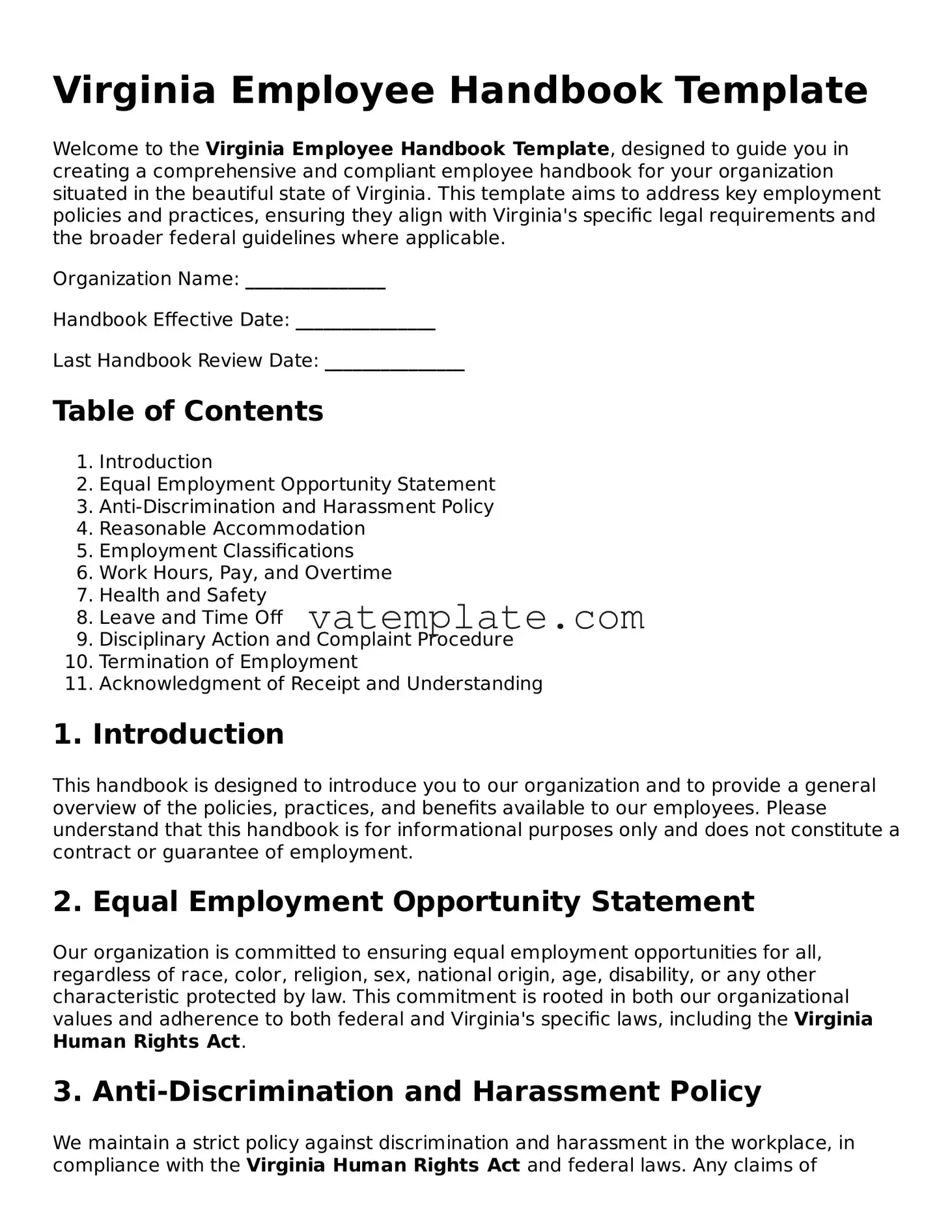Virginia Employee Handbook Template
Welcome to the Virginia Employee Handbook Template, designed to guide you in creating a comprehensive and compliant employee handbook for your organization situated in the beautiful state of Virginia. This template aims to address key employment policies and practices, ensuring they align with Virginia's specific legal requirements and the broader federal guidelines where applicable.
Organization Name: _______________
Handbook Effective Date: _______________
Last Handbook Review Date: _______________
Table of Contents
- Introduction
- Equal Employment Opportunity Statement
- Anti-Discrimination and Harassment Policy
- Reasonable Accommodation
- Employment Classifications
- Work Hours, Pay, and Overtime
- Health and Safety
- Leave and Time Off
- Disciplinary Action and Complaint Procedure
- Termination of Employment
- Acknowledgment of Receipt and Understanding
1. Introduction
This handbook is designed to introduce you to our organization and to provide a general overview of the policies, practices, and benefits available to our employees. Please understand that this handbook is for informational purposes only and does not constitute a contract or guarantee of employment.
2. Equal Employment Opportunity Statement
Our organization is committed to ensuring equal employment opportunities for all, regardless of race, color, religion, sex, national origin, age, disability, or any other characteristic protected by law. This commitment is rooted in both our organizational values and adherence to both federal and Virginia's specific laws, including the Virginia Human Rights Act.
3. Anti-Discrimination and Harassment Policy
We maintain a strict policy against discrimination and harassment in the workplace, in compliance with the Virginia Human Rights Act and federal laws. Any claims of discrimination or harassment are taken very seriously and will be promptly investigated to ensure a safe and equitable work environment.
4. Reasonable Accommodation
Consistent with the Americans with Disabilities Act (ADA) and the Virginia Human Rights Act, we are committed to providing reasonable accommodations for qualified individuals with disabilities to ensure equal access to employment opportunities and benefits of employment.
5. Employment Classifications
Employees are designated as either non-exempt or exempt from federal and state overtime provisions. This classification affects your eligibility for overtime pay among other provisions.
6. Work Hours, Pay, and Overtime
We comply with applicable federal and state laws, including the Virginia Minimum Wage Act, to determine work hours, pay, and overtime policies. Employees will be compensated for all hours worked as prescribed by law.
7. Health and Safety
Our organization adheres to the standards set forth by the Occupational Safety and Health Administration (OSHA) and the Virginia Occupational Safety and Health (VOSH) Program, ensuring a safe work environment for all employees.
8. Leave and Time Off
We provide various leave and time-off benefits, including those mandated by federal and Virginia-specific laws, such as the Virginia Sick Leave and Family Leave policies.
9. Disciplinary Action and Complaint Procedure
It is our policy to ensure fair and consistent disciplinary actions and provide a clear complaint procedure for addressing workplace issues, in line with Virginia's employment laws.
10. Termination of Employment
Termination of employment within our organization will be conducted in accordance with federal and state laws, including the Virginia Employment Commission's regulations.
11. Acknowledgment of Receipt and Understanding
Each employee is required to sign an acknowledgment form confirming the receipt and understanding of this employee handbook. The acknowledgment form also confirms that the handbook is not intended to create a contract of employment and that employment is at-will.
This handbook is not exhaustive and may be updated at any time. We encourage employees to ask questions if any policy or provision is unclear.
